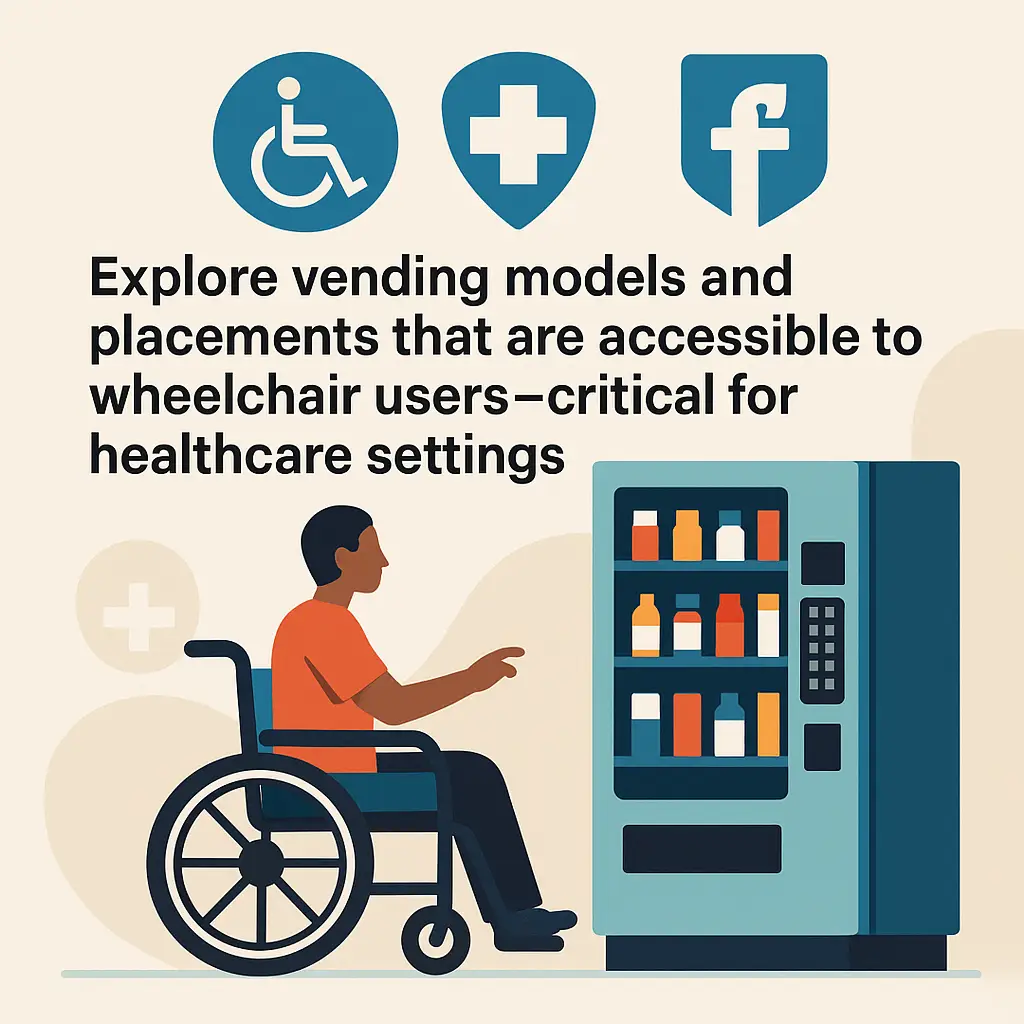Wheelchair-Accessible Vending Machine Options
Explore vending models and placements that are accessible to wheelchair users—critical for healthcare settings.
Back to Vending for Healthcare ResourcesExplore vending models and placements that are accessible to wheelchair users—critical for healthcare settings.
Back to Vending for Healthcare ResourcesA wheelchair-accessible vending machine has lower product rows, reachable controls, and appropriate placement to meet ADA guidelines in healthcare environments.
![]() Accessible design ensures compliance with ADA and healthcare standards
Accessible design ensures compliance with ADA and healthcare standards
![]() Proper placement improves access for patients, staff, and visitors
Proper placement improves access for patients, staff, and visitors
![]() Inclusive machines promote independence and equal opportunities for all users
Inclusive machines promote independence and equal opportunities for all users

Healthcare facilities are responsible for providing inclusive spaces where every patient, visitor, and staff member can access daily conveniences. One critical component is ensuring that wheelchair-accessible vending machines are available in key areas. These units are designed to meet ADA requirements, allowing users to independently select and purchase items without barriers.
Accessible vending machines are built with lower reach ranges so that controls, displays, and product rows are usable from a seated position. Payment terminals are also placed at an appropriate height, ensuring that cash, card, and mobile payment systems can be easily operated. These design choices are especially vital in healthcare facilities, where patients with mobility challenges rely on self-service access.
Accessibility is not only about machine design but also about placement. Machines located in wide hallways, waiting rooms, or near staff lounges provide convenient and safe access for wheelchair users. Improper placement, such as in narrow corridors or crowded spaces, can create unnecessary obstacles. Hospitals, rehabilitation centers, and clinics benefit from thoughtful placement strategies that prioritize inclusivity and reduce congestion.
When vending machines are accessible to all users, they promote independence and equal opportunity. Patients gain confidence knowing they can purchase snacks or drinks without assistance, while visitors appreciate being able to access refreshments during long waits. Staff also benefit, particularly in high-stress environments where quick access to hydration and energy is important.
Many modern machines now include touchless payment systems, brightly lit displays, and wider product doors that enhance usability for wheelchair users. These updates not only meet compliance requirements but also improve the overall experience for every user. Integrating inclusive technology supports healthcare facilities in offering safe, reliable, and equitable vending services.
For facilities exploring how vending machines can improve patient and staff convenience, it may be helpful to review touchless vending technology in hospitals. Additionally, understanding options like coffee and tea vending for healthcare facilities provides insight into accessible beverage solutions. On the business side, articles such as micro market versus vending comparisons and AI cooler versus traditional vending analysis expand awareness of equipment selection that supports accessibility goals.
If you're exploring vending options for your business, Vending Exchange can help simplify the process. Delivery, Installation and Equipment is provided at no cost to you - vendors provide the machines, keep them stocked, and handle all servicing. Whether you need a provider or full-service management, just fill out the form on this page to get started.
They ensure that patients, staff, and visitors with mobility challenges can independently access snacks, drinks, and other items without barriers.
Lower reach ranges, accessible payment terminals, and easy-to-open doors help vending machines meet ADA compliance standards.
They should be placed in wide hallways, waiting rooms, staff lounges, and other areas where space allows easy wheelchair maneuverability.
Yes, these machines provide a full selection of snacks and beverages, designed for accessibility without reducing product variety.
Accessible machines use terminals positioned at wheelchair height and often include contactless payment options for added convenience.
Yes, staff in fast-paced healthcare environments benefit from quick, independent access to refreshments during long or late shifts.
Machines in narrow spaces or crowded hallways create obstacles for wheelchair users, reducing access and causing frustration.
Yes, many feature touchless payments, illuminated displays, and wide product openings to improve usability for all users.
No, they are valuable in clinics, rehabilitation centers, nursing homes, and any healthcare facility serving diverse mobility needs.
They promote independence, reduce reliance on assistance, and create an equitable experience for all facility users.